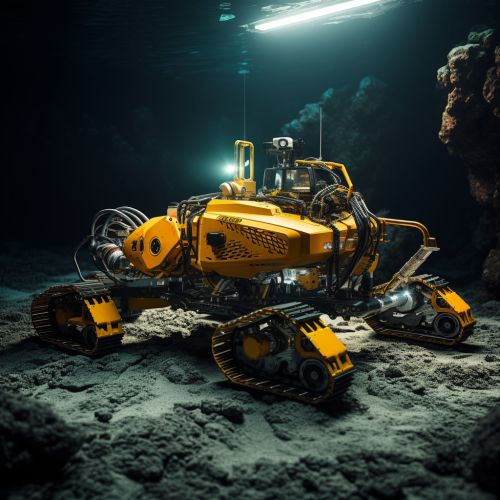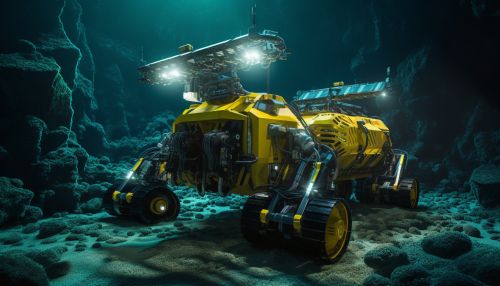The Ecology of Deep-Sea Mining and Environmental Impacts
Introduction
Deep-sea mining is the process of retrieving mineral deposits from the deep sea, the area of the ocean below 200 meters. It involves the extraction of mineral resources such as manganese nodules, cobalt-rich crusts, and polymetallic sulfides, which are rich in elements such as copper, nickel, cobalt, and rare earth elements. These resources are considered crucial for the development of green technologies, including electric vehicles and renewable energy infrastructure.


Deep-Sea Mining Methods
There are three main methods of deep-sea mining: nodule mining, crust mining, and sulfide mining. Each method targets a specific type of mineral deposit and requires specialized technology and equipment.
Nodule Mining
Nodule mining targets manganese nodules, which are potato-sized rocks rich in manganese, nickel, copper, and cobalt. These nodules are found scattered across the abyssal plains, the flat, sediment-covered areas of the deep sea. The mining process involves the use of remotely operated vehicles (ROVs) to collect the nodules and transport them to the surface.
Crust Mining
Crust mining targets cobalt-rich crusts, which are layers of heavy metal deposits found on the slopes of seamounts. These crusts are rich in cobalt, platinum, and other valuable metals. The mining process involves the use of cutting tools to scrape the crust off the seamount and suction pumps to transport the material to the surface.
Sulfide Mining
Sulfide mining targets polymetallic sulfides, which are mineral deposits formed around hydrothermal vents. These vents are openings in the seafloor where heated, mineral-rich water is ejected. The mining process involves the use of ROVs to cut the sulfide deposits and transport them to the surface.
Environmental Impacts of Deep-Sea Mining
The extraction of mineral resources from the deep sea has the potential to cause significant environmental impacts. These impacts can be categorized into three main types: physical, chemical, and biological.
Physical Impacts
Physical impacts are caused by the disturbance of the seafloor and the water column during the mining process. These impacts include the removal of the top layer of sediment, the creation of plumes of suspended particles, and the alteration of seafloor topography. These changes can lead to the loss of habitat for benthic organisms, the reduction of light penetration, and the alteration of current patterns.
Chemical Impacts
Chemical impacts are caused by the release of toxic substances during the mining process. These impacts include the release of heavy metals, the alteration of seawater chemistry, and the potential for acid mine drainage. These changes can lead to the contamination of marine ecosystems, the alteration of nutrient cycles, and the potential for bioaccumulation of toxic substances in marine organisms.
Biological Impacts
Biological impacts are caused by the disturbance and potential destruction of marine ecosystems. These impacts include the loss of biodiversity, the alteration of community structure, and the potential for species extinction. These changes can lead to the disruption of ecosystem services, the alteration of food webs, and the potential for irreversible ecological change.
Mitigation and Management of Environmental Impacts
The mitigation and management of the environmental impacts of deep-sea mining is a complex and challenging task. It requires the development of effective regulatory frameworks, the implementation of best practice guidelines, and the application of adaptive management strategies.
Regulatory Frameworks
Regulatory frameworks for deep-sea mining are currently being developed by international bodies such as the International Seabed Authority (ISA). These frameworks aim to ensure that deep-sea mining activities are conducted in a manner that minimizes environmental impacts and promotes sustainable use of marine resources.
Best Practice Guidelines
Best practice guidelines for deep-sea mining are being developed by industry and research institutions. These guidelines aim to provide practical advice on how to conduct deep-sea mining activities in a manner that minimizes environmental impacts. They cover areas such as environmental impact assessment, monitoring and management, and post-mining restoration.
Adaptive Management Strategies
Adaptive management strategies for deep-sea mining involve the ongoing monitoring of environmental impacts and the adjustment of mining activities in response to these impacts. These strategies aim to ensure that deep-sea mining activities are conducted in a manner that is responsive to changing environmental conditions and scientific understanding.
Conclusion
Deep-sea mining has the potential to provide a significant source of mineral resources for the development of green technologies. However, it also has the potential to cause significant environmental impacts. The challenge for regulators, industry, and society is to ensure that deep-sea mining is conducted in a manner that balances the need for mineral resources with the need to protect the marine environment.
